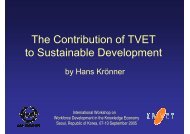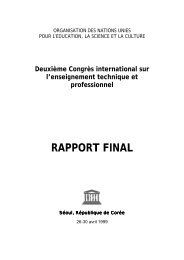Learning for Life, Work and the Future Initial ... - Unesco-Unevoc
Learning for Life, Work and the Future Initial ... - Unesco-Unevoc
Learning for Life, Work and the Future Initial ... - Unesco-Unevoc
You also want an ePaper? Increase the reach of your titles
YUMPU automatically turns print PDFs into web optimized ePapers that Google loves.
<strong>Learning</strong> <strong>for</strong> <strong>Life</strong>, <strong>Work</strong> <strong>and</strong> <strong>the</strong> <strong>Future</strong> Participants’ Papers Page 77<br />
• The instructor has <strong>the</strong> responsibility <strong>for</strong> translating<br />
<strong>the</strong> st<strong>and</strong>ard into a learning experience to enable a<br />
trainee to achieve given per<strong>for</strong>mance criteria.<br />
Train towards<br />
<strong>the</strong> st<strong>and</strong>ards<br />
Occupational Unit St<strong>and</strong>ards<br />
<strong>for</strong> a given duty or task<br />
Assess against<br />
<strong>the</strong> st<strong>and</strong>ards<br />
Training<br />
delivery<br />
Service/<br />
<strong>the</strong> product<br />
Assessment<br />
system<br />
<strong>Learning</strong> process ensures<br />
integration of both practice<br />
<strong>and</strong> <strong>the</strong>ory-knowledge<br />
according to defined<br />
per<strong>for</strong>mance criteria<br />
Competent Person<br />
Measuring to given st<strong>and</strong>ards<br />
Ensures adherence to<br />
service/production processes<br />
<strong>and</strong> end-products are as per<br />
given st<strong>and</strong>ard <strong>and</strong> assessing<br />
criteria of practical <strong>and</strong><br />
knowledge competencies<br />
The CBET concept in a nutshell<br />
3. Making CBET Operational<br />
In order to put CBET into practice, VETA has adopted<br />
an occupational Unit St<strong>and</strong>ard <strong>for</strong>mat. This <strong>for</strong>mat<br />
looks at a total occupation <strong>and</strong> its subsequent employable<br />
tasks, as analysed in a Dacum chart. The benefits<br />
of this approach are that it gives a strong base <strong>for</strong><br />
modularised training in which <strong>the</strong> trainee may select<br />
specific units, <strong>the</strong> full cycle or units, or mix units from<br />
different occupations. The approach gives room <strong>for</strong><br />
narrowing, broadening <strong>and</strong> even multi-skilling, depending<br />
on employment requirements. Trainee<br />
enrolment is based on assessment of prior knowledge,<br />
<strong>and</strong> exit determined by <strong>the</strong> trainee’s satisfaction that he<br />
has achieved what he wanted <strong>for</strong> job per<strong>for</strong>mance. The<br />
occupational unit st<strong>and</strong>ards <strong>the</strong>re<strong>for</strong>e <strong>for</strong>m <strong>the</strong> basis <strong>for</strong><br />
both <strong>for</strong>mal long courses <strong>and</strong> non-<strong>for</strong>mal short courses<br />
as dem<strong>and</strong>ed.<br />
4. Implications <strong>for</strong> Assessment <strong>and</strong> Testing<br />
Unit-based assessment has introduced flexibility in<br />
testing. Assessment is continuous <strong>and</strong> carried out once<br />
a given unit-st<strong>and</strong>ard is achieved. This enables immediate<br />
feedback to <strong>the</strong> trainee <strong>and</strong> <strong>the</strong>re<strong>for</strong>e enhances<br />
trainee motivation, since knowledge of progress <strong>and</strong><br />
success becomes an integral part of <strong>the</strong> learning<br />
process. Since units are constructed from employable<br />
tasks in a particular occupation, a cluster of units<br />
<strong>for</strong>mulates an occupational area, while description of<br />
unit-based qualifications defines <strong>the</strong> different levels.<br />
Unit-based certification/accreditation gives flexibility<br />
to those wishing to be certified <strong>for</strong> a particular task/job.<br />
However, <strong>for</strong> <strong>the</strong> purpose of career progression,<br />
national certification will be provided to accredit a<br />
level-based qualification. The processes will <strong>the</strong>re<strong>for</strong>e<br />
involve:<br />
Unit certification by <strong>the</strong> principal <strong>and</strong> instructor to sign<br />
off a trainee, verifying competence achieved, with<br />
nationally accredited assessors validating <strong>the</strong> qualification.<br />
For those on long-term training, a logbook will be<br />
filled out after every unit, so as to certify competence<br />
achievement. Once again an external assessor will<br />
verify attainment of required competence at a given<br />
level.<br />
A level-based certificate will be issued based on<br />
achieved required units in a given occupation.<br />
The procedure is to conduct national tests at three<br />
levels, based on modules, which <strong>the</strong>mselves are based<br />
on a cluster of units. Hence certification based on<br />
achieved competency <strong>for</strong> a unit would mean a step<br />
towards accreditation. Regulation occurs through <strong>the</strong><br />
use of external assessors who are nationally registered<br />
<strong>and</strong> vetted. The assessors are to be approved by Trade<br />
Advisory Committees.





